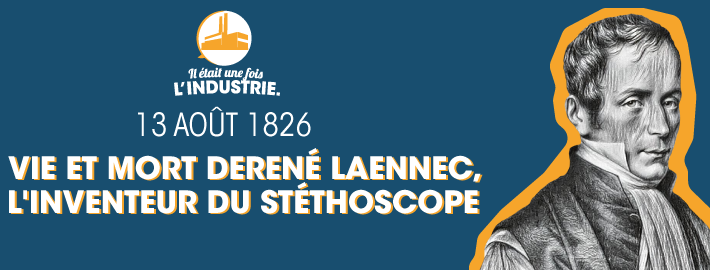GLOBAL
INDUSTRIE
News
Share on

13 August 1826: life and death of René Laennec, inventor of the stethoscope
What happened this week in the History of Industry? It is to answer this question that Global Industrie invites you to rediscover, every week, a key event which occurred around this time… in another age. Let’s look back today at the life – and premature death, on the 13th of August 1826 – of a French doctor who revolutionized medicine and literally breathed new life into his profession.
A MAN WITH BOTH PROFESSIONAL AND HUMAN QUALITIES
René Laennec – that was his name – was born on the 17th of February 1781 in Quimper into a middle-class family, the son of a lawyer. This was also the profession of his grandfather, who had additionally been mayor of the famous town in Finistère. René unfortunately lost his mother very young when she died of tuberculosis in 1786, a first painful incursion of a disease which was to mark his whole life…
His father proving to be incapable of looking after him, he was entrusted to his uncle, who happened to be a professor and director of Nantes Medical School. Following his example, he began studying medicine in the City of the Dukes… before continuing his studies in the City of Kings: Paris.
A particularly brilliant student, in 1802, at the age of just 21, he received the two major medicine and surgery prizes awarded by the École Pratique before qualifying as a doctor in 1804. He then set up his own practice, his patients including Madame de Staël and Chateaubriand as well as many needy people. A very pious Catholic, Laennec was indeed famed as much for his charity to the poor as for his professional qualities. Thus it was that in 1816 he was appointed at the Necker Hospital where he took a particular interest in… tuberculosis.
THE STUFF OF INVENTORS
René Laennec was then, like his colleagues, faced with a major problem. The examination of patients’ lungs, conducted by the doctor placing his ear directly on their chest, ran up against the barrrier of the muscles and bones which reduce perception of sounds… A problem to which he found a solution, according to tradition, on the 17th of February 1816.
On that day, while crossing the courtyard of the Louvre, where building work was being carried, on his way to the hospital, he saw some children playing with materials and tools left on site by the workers. One of them was using a needle to strike the end of an oak beam. His playmate, positioned at the other end, had to guess the number of blows struck by pressing his ear to the beam. On arriving at his surgery, he found himself in the presence of a very plump young patient whose chest attenuated the sound of her heart. Remembering the children he had seen, he then had the idea of rolling up a bundle of papers from his casebook, which he always carried with him, and placing it on her chest to amplify the sound of her heartbeat. “Mediate” auscultation (with the help of an instrument) had been invented!
DIVERSE AND VARIED APPLICATIONS
René Laennec, who published his Treatise on Mediate Auscultation in 1819, constantly improved upon his invention, which he called a "stethoscope", literally meaning "chest observation" in Greek. He built several models consisting of a wooden cylinder with a 6 mm hole bored through it. This design was subsequently improved around 1830 by Pierre Piorry, who added an ivory adapter at the ear end. Around the same time, a flexible tube was devised to connect the chest-piece to the earpiece, but the rigid model continued to be used for another few decades. The binaural stethoscope, for both ears, was first thought of in 1829, but not constructed until 1851. Far from being limited to examining living beings, the device was also successfully used by safe-breakers, plumbers, locksmiths, mechanics and mine-clearers, among others!
The ingenious doctor unfortunately did not have time to see all of these developments. Suffering from tuberculosis himself, he retired to his Kerlouarnec manor in Ploaré, near Douarnenez, where he died on the 13th of August 1826, at the age of 45. He left his nephew, himself a doctor, his very first stethoscope, which he considered to be "the greatest legacy of his life".
"Stethoscope: an unlikely cross between Walkman headphones and an Olympic medal"– Stéphane Germain
2021.08.16